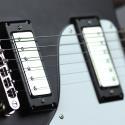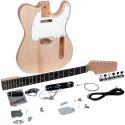A Comprehensive Guitar Parts Diagram Guide
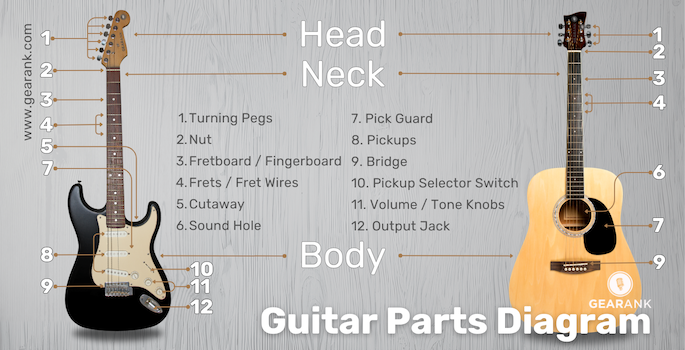
Using a guitar parts diagram is an effective method to get students acquainted with the various components of a guitar.
With this visual aid, students can familiarize themselves with the different parts of the guitar, even in the absence of their instrument.
Knowing the different guitar parts and their purpose is pivotal in learning and mastering the instrument. This is why I often cover this topic right at the start, regardless of the student's experience level.
In this article, you'll learn about
-
Guitar Parts Diagram
-
Guitar Headstock/Guitar Head/Machine Head
-
Guitar Neck
-
Guitar Body
-
Features Unique to Acoustic Guitars and Electric Guitars
Let's start by answering the Why question.
Why you need a Guitar Parts Diagram
To make the most of your instrument, you need to know its ins and outs. This will allow you to play the instrument better, and maintain it in good working order.
Knowing how each part works can help you better perform simple maintenance like string changing, truss rod adjustment, and cleaning different components.
You'll also need to know the parts when communicating with other musicians and asking advice from techs.
Knowing how each part works is also essential when upgrading guitar parts.
What is a Guitar Parts Diagram
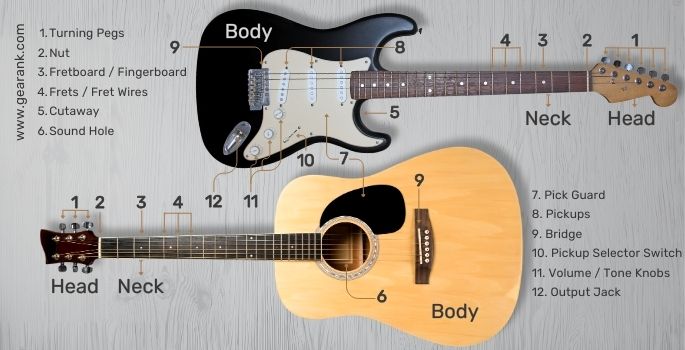
A guitar parts diagram lists the different parts of guitars and shows where they are on the instrument.
Some diagrams are specific to a guitar type, but there are diagrams that cover both acoustic and electric guitars.
It is best to get a diagram that's specific to the guitar you're using, but it is also beneficial to know the parts of other guitar types, especially if you regularly interact with other guitarists.
The three major parts of a guitar include the headstock, neck, and body. And these three have different components, all of which have their essential roles.
Read on to learn more about the three main parts and their sub-components.
Guitar Headstock / Guitar Head
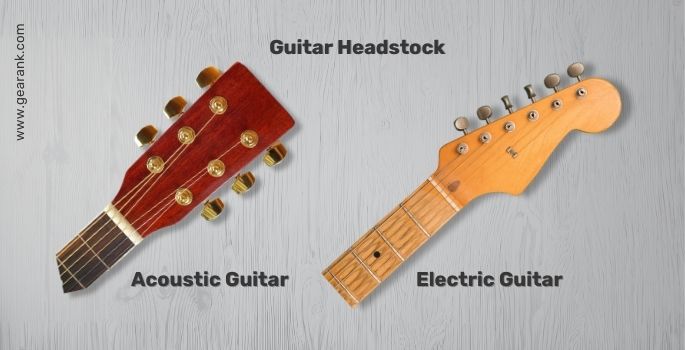
Atop a guitar's neck is the guitar headstock. Its primary purpose is to hold down the strings and enable tuning (string tension adjustment) and structural stability.
Tuning Pegs
Tuning pegs are the knob-like parts on a guitar's headstock that adjust string tension.
This allows you to tune the guitar strings to the correct pitch. You'll have to turn the tuning pegs for regular guitars, and the same process applies for 7-string tuning.
The tuning peg pegs are also seen on other stringed instruments like the violin, cello, double, and more.
In the case of headless guitars, the tuning pegs can be found on the bridge. Floyd Rose bridges also feature a tuning function on their bridges.
Guitar Nut
The guitar nut is located roughly where the neck meets the headstock. It's often made up of bone/ivory, plastic, or metal.
This part evenly spaces the strings. It also helps maintain the fret's position and string height above the fretboard. Overall, it contributes to proper string action and better sound quality.
Guitar Neck
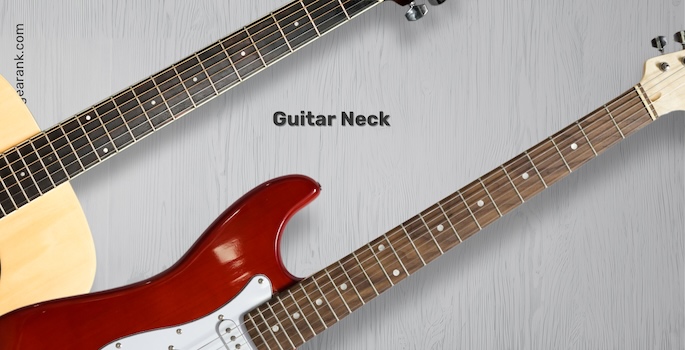
A guitar neck is the long, slender part of the guitar that extends from the body. Its main function is to support the fretboard, frets, and strings, allowing players to press down the strings and produce different notes.
Below are the components that you'll find in a guitar neck.
Fretboard/ Fingerboard
Usually made up of wood, a guitar fretboard is a thin material that is laminated to the guitar's neck.
Over the fretboard is where the guitar strings run. Pressing the strings against the fretboard shortens the strings, resulting in the pitch we hear.
Truss Rod
A truss rod is a metal bar that supports the structural stability of the guitar neck.
Aside from stability, the truss rod lets you do neck bow adjustments (curvature of the guitar neck) to maintain proper string height and playability.
It is accessed through an opening in the headstock, which is mostly hidden by a metal or plastic cover. In some, it is between the guitar neck and guitar pickup. While on some acoustic guitars, it can be accessed through the sound hole.
Frets/Fret Wires
These are metal strips lodged on the fretboard of a stringed instrument like a guitar. This divides the entire neck into a segment of semitones, which allows you to map the notes found on the neck.
Often dots or other shapes, fret markers are visual indicators on the fretboard of a guitar. They help players locate the position of notes, making it easy to navigate the fretboard.
Heel or Neck Joint
The point where the guitar's body meets the neck is called a heel or neck joint. This joint is designed for structural stability and support for the string tension.
There are different neck joint types for electric guitars, including bolt-on, set-neck, and neck-through. Acoustic guitars usually come with traditional dovetail set-neck joints.
Guitar Body
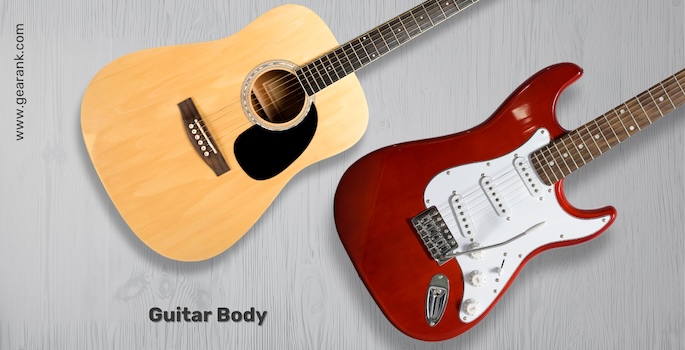
A guitar body is the largest part of a guitar. Its main function is amplifying string vibrations via a sound hole or pickup. It holds down the other end of the guitar strings as well.
There are three common electric guitar body types: hollow body, semi-hollow body, and solid body.
Common acoustic guitar body types include dreadnought, jumbo, parlor, grand auditorium, and concert.
Below are the components associated with the guitar body.
Pickguard
A pickguard is a piece of material (usually plastic) attached to a guitar's picking area. This part protects the guitar's body from scratches that could come from playing.
Bridge
This guitar part holds the steel strings down to the guitar body, allowing for proper tensioning or tuning. It transfers the vibrations from the strings to the body for amplification and helps set the string height for playability. It also influences intonation, sustain, and the guitar's overall tone.
Saddle
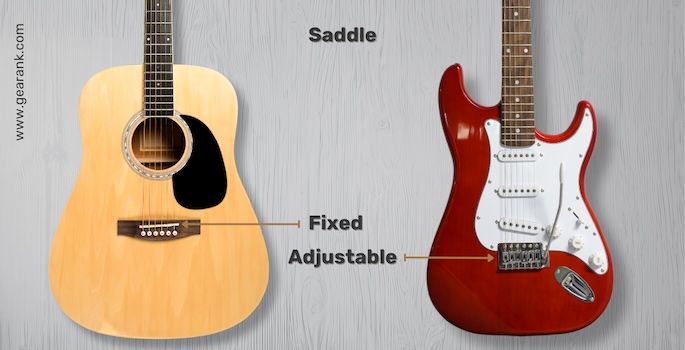
A saddle is made of bone or plastic for acoustics, while metal is often used on electric guitars.
When it comes to tone, a guitar's saddle transfers the string's vibration into the guitar's body. This, in a way, affects the instrument's sound.
Note: An acoustic guitar bridge saddle is generally fixed, while an electric guitar bridge saddle has adjustable features for string height and intonation.
Cutaway
A cutaway is a cutout portion of a guitar's body that creates a curved indentation. This is done to facilitate higher fret access with fewer obstacles.
Note: While cutaways are almost always present on electric guitars (except for a few models), some acoustic guitars also prefer to have them. Meanwhile, on classical guitars, having one is also frowned upon.
Unique Features
Aside from the guitar parts mentioned above, some almost exclusively belong to a specific guitar type. Here are some examples of those.
Features More Common on an Acoustic Guitar
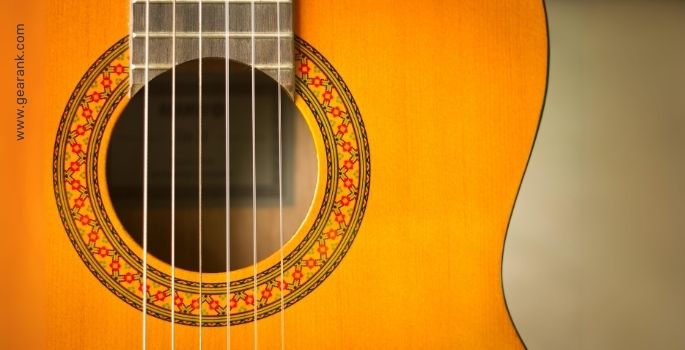
Sound Hole
A hollow-body guitar typically has a sound hole in its body. Usually found in the middle of an acoustic guitar's body, a sound hole enhances the sound of your playing.
The sound hole then transforms the initial vibrations into sound after amplifying them with its hollow body. So, simply put, a sound hole functions like a speaker.
Acoustic Guitar Bracing
Because of its hollow body, an acoustic guitar needs internal bracing to support its structure. This features an arrangement of wooden struts to strengthen the back and top of an acoustic guitar.
Aside from structural purposes, braces also affect the guitar's overall tone.
In a steel-string acoustic guitar, thinner or lighter braces will create more resonance and bass response. Thicker braces will have a more controlled response with less resonance compared to the former.
Bridge Pins
These small posts (mostly made of plastic) hold the steel strings in place. They secure the strings to the bridge, help maintain tension, and transmit the string vibrations to the guitar body.
Note: These are features that are generally common in acoustic guitars. Some electric guitars also have some of these features, e.g., a semi-hollow electric guitar.
Features More Common on an Electric Guitar
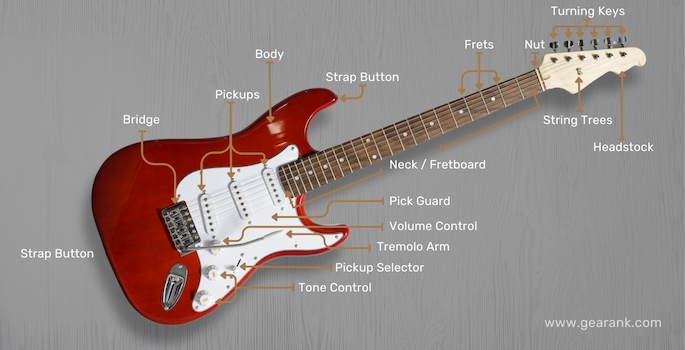
String Trees or String Retainers
String trees are metal guides on an electric guitar's headstock. These widgets press down the strings to help maintain proper string tension.
They also help improve tuning stability and sustain, most especially for strings closer to the headstock.
Tremolo Arm/Vibrato Arm/Whammy Bar
A tremolo arm/vibrato arm/whammy bar is a metal rod on an electric guitar. This piece is often situated on the guitar bridge.
By altering the string tension, it changes the guitar's pitch. This creates a wobbly or wavy effect on the sound.
Electric Guitar Pickups
An electric guitar pickup is a device that converts electrical signals into sound. It absorbs the vibrations from your playing and turns them into electricity, then sends them to an amp through a cable.
Volume and Tone Knob Controls
An electric guitar's tone knob controls the brightness or warmth of your sound. A volume knob, on the other hand, controls the loudness of your guitar's sound.
Pickup Selector Switch
This is an electric guitar feature that allows you to choose different pickup combinations.
The selected pickup will affect the sound your guitar produces.
For example, if you select the bridge pickup, you'll get a punchy sound, while if you select the neck pickup, you'll get a warm and compressed sound. Some have a center pickup, which produces a clearer tone.
Other guitars feature pickup selectors with options where you can split the pickups. For example, a middle-neck pickup and a middle-bridge pickup.
Output Jack
An output jack on a guitar is a socket where you can plug in a cable to connect your guitar to an amp or a speaker. It allows the transmission of electrical signals from your playing to external devices for amplification or recording.
Note: These are features that are generally common in electric guitars. Some acoustic guitars also have some of these features, e.g., An acoustic-electric guitar.
Final Thoughts
To sum it up, grasping the intricacies of the guitar's anatomy is akin to knowing the tools of your trade.
Now you know how to better utilize a guitar parts diagram, and have a more accurate knowledge of the function of each parts.
This knowledge will be a big help in improving your playing experience, and will help you better care for your instrument.
Contributors:
Jerome Arcon - Co-writer
Jerry Borillo - Illustrator





